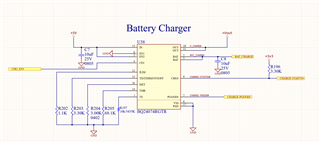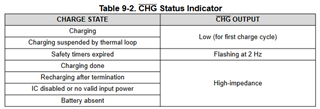

1) The battery charges "successfully" as in, as measured by a DMM, the current into the battery is dropping below the termination current and the voltage is up ~4.2V. I started with a battery at 3.6V.
2) The CHG pin does not change. It is always low.
3) I would also expect the CHG pin to go HI-Z when I remove the battery entirely, and it just stays low.
4) If I disable the IC, CHG does go hi-z as expected with table 9-2, so the output isn't physically broken
CHARGE-STATUS# port used to be connected to a pin on my MCU, but I've since cut the trace entirely and I'm measuring at the pullup resistor.

